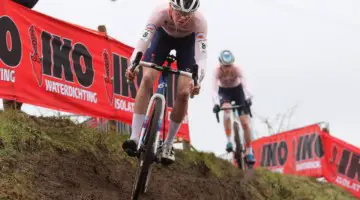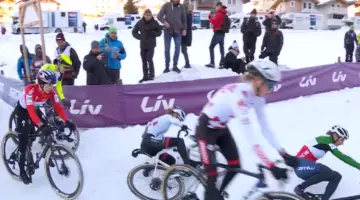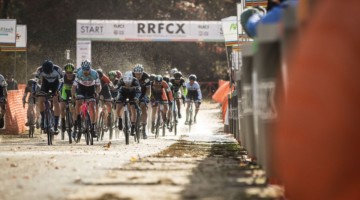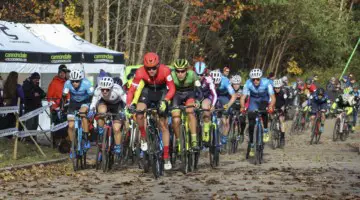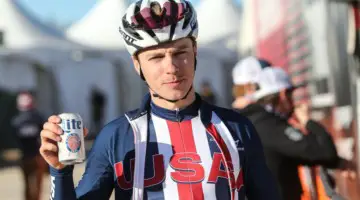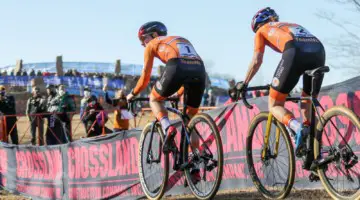Last cyclocross season was a big one for Maghalie Rochette. Shortly before the Rochester Cyclocross weekend, Rochette announced she was leaving the Clif Pro Team to start her own CX Fever p/b Specialized program to focus specifically on cyclocross.
Rochette launched her new program by winning both days in Rochester, and she then went on to win the Pan-American Championships and Canadian Nationals on consecutive weekends.
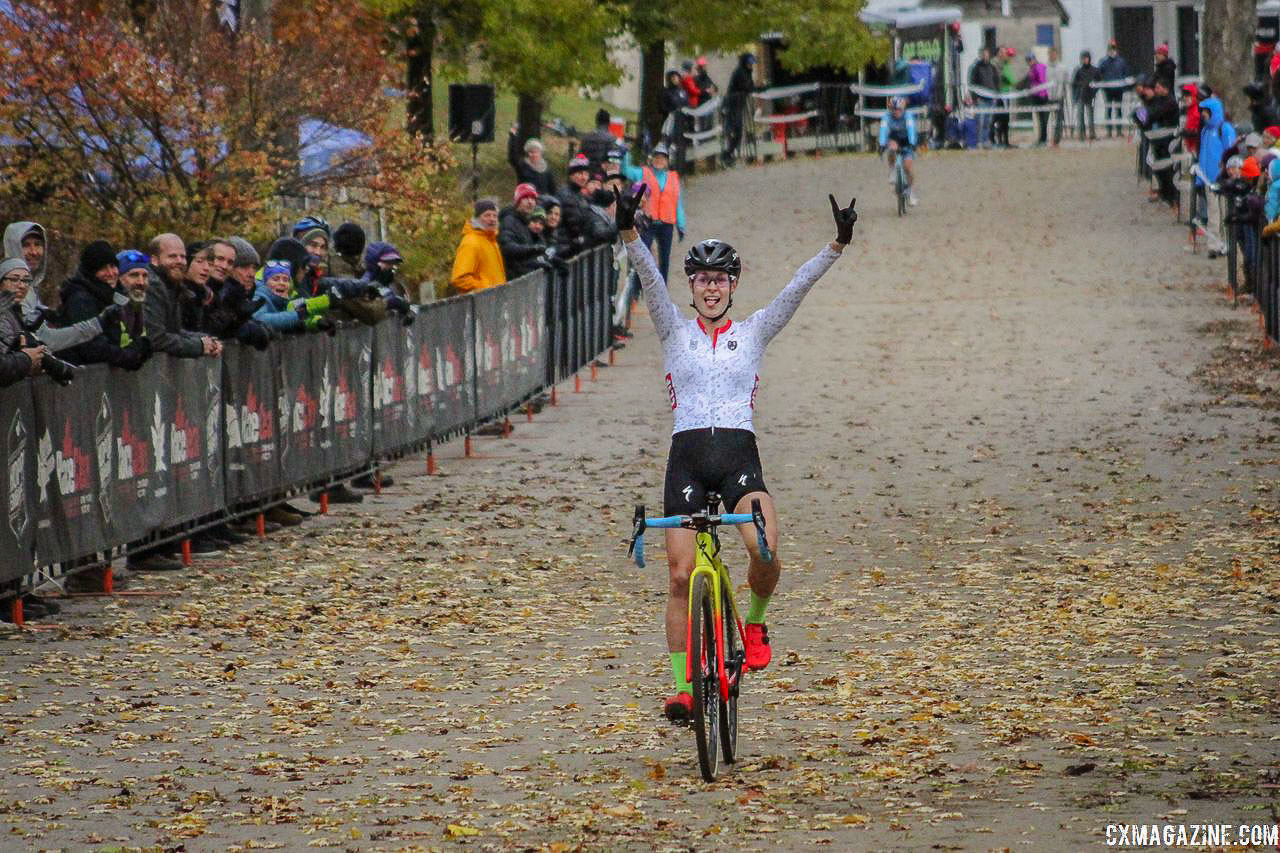
Maghalie Rochette gave Midland a case of CX Fever on Sunday. 2018 Pan-American Cyclocross Championships, Midland, Ontario. © Z. Schuster / Cyclocross Magazine
Rochette, who finished 5th at the 2017 World Championships in Bieles, then packed up and headed to Europe with her partner David.
Living in Europe proved to be a tough challenge for the Canadian duo. Rochette said illness, unexpected expenses and boredom all played a factor in results that were not up to her high standards. Still, it was not a wasted trip.
“The racing started out really well, but it didn’t end super well. But at the same time, going to Europe for such a long time with my boyfriend David, who is also my mechanic and partner and the one helping me build the team, was a good experience,” Rochette said. “We learned a lot about how it works there. Although I didn’t have great performances, I think it was very beneficial.”
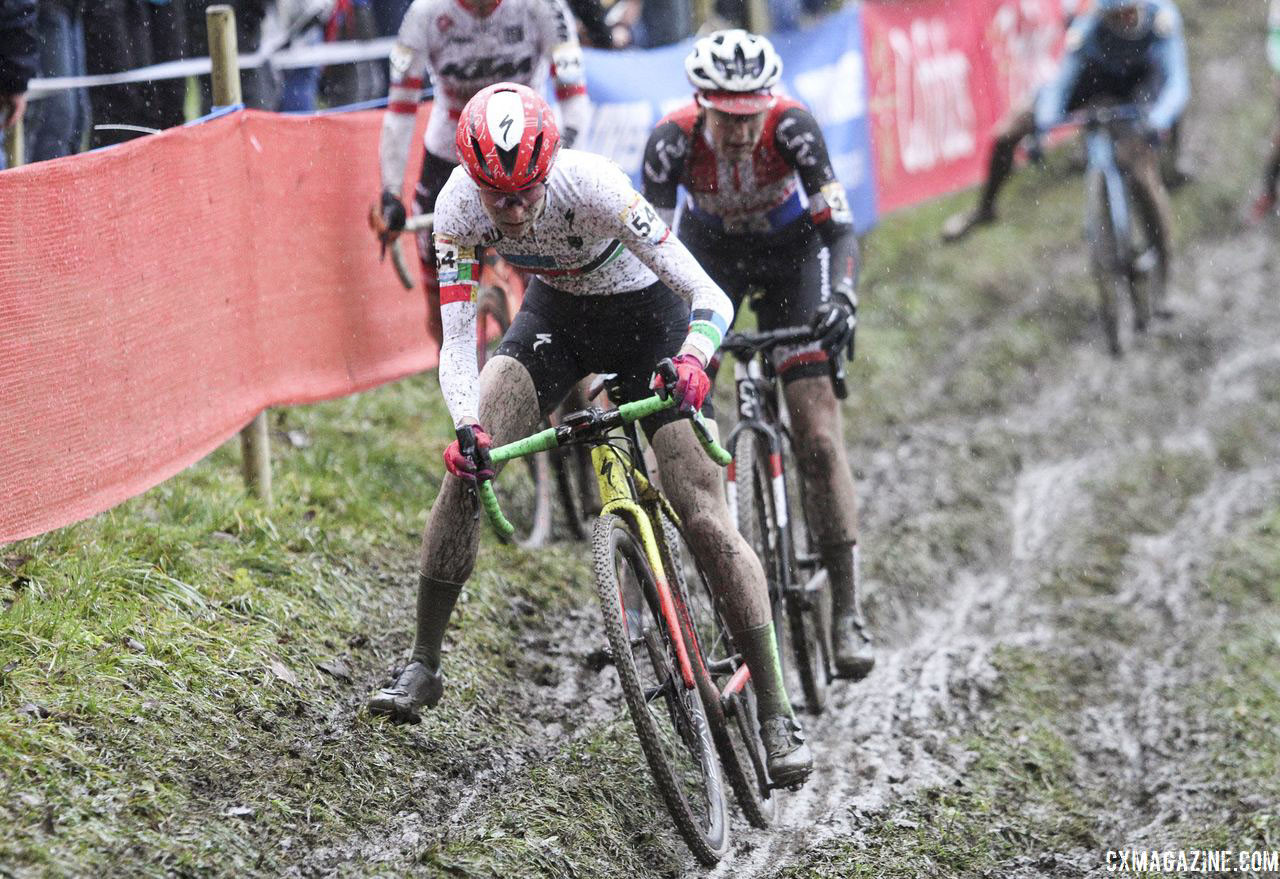
Rochette found a bumpy road in Europe last season. 2018 World Cup Namur. © B. Hazen / Cyclocross Magazine
In past years with Clif, Rochette has spent her summers racing the UCI XCO World Cup circuit and other mountain bike races in North America. Starting CX Fever has also opened Rochette’s summer up. She raced the Rasputitsa gravel race in April and then Canadian Road and Mountain Bike Nationals along with a few other mountain bike events.
Her #crossiscoming racing is not complete, however. Rochette also has plans for an electrifying end to the offseason.
“I’ve been riding my e-bike because I’m doing the E-Mountain Bike World Championships,” Rochette said. “The Mountain Bike World Championships are in Canada this year in Mont-Sainte-Anne, and for the first time ever, they have an E-Mountain Bike World Championship. So I’m doing that. Specialized has a super-cool e-mountain bike, and I’ve been riding that a lot this summer. I’m excited to race on it.”
Rochette said she was skeptical about riding an e-bike, but after a summer prepping to race e-Worlds, she said it has been beneficial from a training standpoint.
“A lot of times when you do a big workout in the morning and then go back out in the afternoon, you’re too cracked to do anything that’s helpful technically because you’re going too slow, but the e-bike allowed me to go at almost a race-pace speed. Going that fast, I could challenge myself technically without being completely exhausted,” she explained.
When she is not e-ripping, Rochette is finishing her preparations for her 2019/20 cyclocross season scheduled to start on September 7 in Rochester. She will be racing a full domestic calendar while traveling back and forth to Europe for the World Cups and Kerstperiode.
I chatted with Rochette while she was home in Quebec. We covered a lot of ground from her experience living in Europe, running her own program, training without racing as much during the summer, her woodworking hobby and of course, e-bikes.
You can read a transcript of our conversation below.
Interview: Maghalie Rochette Readies for CX Fever Year 2
Cyclocross Magazine: What have you been up to this summer?
Maghalie Rochette: It’s been different for me this summer. For the first time, I didn’t really race very much cross country, so that meant spending more time at home and actually having time to train, which has been super fun. It’s been a little bit different. I’ve done a few gravel events, and I’ve been riding my e-bike because I’m doing the E-Mountain Bike World Championships.
CXM: Wait, what?
MR: I knew that was going to bring some questions! The Mountain Bike World Championships are in Canada this year in Mont-Sainte-Anne, and for the first time ever they have an E-Mountain Bike World Championship. So I’m doing that. Specialized has a super-cool e-mountain bike, and I’ve been riding that a lot this summer. I’m excited to race on it.
It’s funny because I was skeptical about the e-bike. I was okay with riding a normal bike, but then I tried it and was like the most fun thing ever. You can go full gas all the time if you want. Basically, your limitation is how fast you’re willing to go. The bike will give you 250 watts on top of what you’re already putting in, so you can go really fast. It’s a question of being super-focused and super-agile on the trails. It’s really euphoric to ride. I finish and I’m just smiling.
CXM: Last year I was out in Colorado and there you basically ride up for an hour or whatever and then rip down. We ran into this dude who was in his 60s who was riding an e-mountain bike, and he was having the time of his life. He said, “I wouldn’t be able to do this otherwise.” It was cool for him, but what’s it like for a trained athlete like yourself? You described a little bit of it.
MR: What I think is really fun about it is I can go really hard if I want to. The bike doesn’t prevent me from pushing hard, but at the same time, if I want to go easy, I can. I’ve been using it as a tool for training. I rode my normal bike most of the summer, but at least twice a week, I’d say, I would go on an e-mountain bike ride.
The way I would use it is I would do a really hard workout of 2 or 3 hours in the morning and then late in the afternoon, I would go out for an hour or so on the e-bike. A lot of times when you do a big workout in the morning and then go back out in the afternoon, you’re too cracked to do anything that’s helpful technically because you’re going too slow, but the e-bike allowed me to go at almost a race-pace speed. Going that fast, I could challenge myself technically without being completely exhausted. I thought that was a cool addition to my training.
CXM: That’s a good point. It’s cool you were able to incorporate it into your training that way.
MR: As I said, I was really skeptical at first, but then I really found benefits to it. But mostly, it was a lot of fun. But I’ve been doing other things this summer. I haven’t just been riding the e-bike.
CXM: By home do you mean up in Canada or down in Tucson?
MR: Great question. I’ve mostly been home in Canada.
CXM: Haven’t you been spending a good amount of time in Tucson though?
MR: After Cyclocross Worlds, I came back here for a bit. I did a little bit of skiing and a few winter activities, but then I decided to head down to Tucson to be able to ride my bike.
But I really did things differently this year. I took a big break after Cyclocross Worlds. I was cracked, so I decided to just chill for a long time and not stress or overtrain. I think for a month I pretty much did nothing. I was mostly having fun, doing some skiing and a little bit of hiking, but nothing that was actually training.
Then I started moving a little bit but in an unstructured way. At the end of April is when I actually started with solid training. That’s when I came back home to Canada. I was in Tucson from February to April, and then I arrived in Canada for the Rasputitsa gravel race.
CXM: I saw you did Nationals for both mountain bike and road?
MR: Yep.
CXM: Are those and Rasputitsa mostly the races you’ve done? How have you gotten intensity in your legs?
MR: I started with the enduro and gravel race at Sea Otter, and then I did the gravel race in Vermont. Then I did some of the Canada Cup mountain bike races, and after that I did Road Nationals and Mountain Bike Nationals. This month I will be doing a couple more gravel events. It hasn’t been as much racing as I’m used to, but I feel like I’ve still had the intensity. We’ll see how it translates when cyclocross season starts.
But I’m the kind of person who can push pretty much as hard in training as I do in races, if not more. I usually struggle to be as strong in races as I am in training. So for me, I don’t think it’s too much of a factor. But I have a bunch of guy friends here who I train with. You know how guys are, they’re just constantly attacking each other. That’s pretty intense training trying to keep up and attacking them for fun. Then as part of our training we do a lot of motor pacing. I think that’s similar to what racing brings as well.
We’ll see. This is the first time I am doing it this way where I don’t race as much in the summer. We’ll see how it translates, but right now, I feel like it will be positive because I think I am going to be so much fresher when the season starts.
CXM: I want to ask about this before I forget. We covered Rasputitsa, and I saw the really awesome prizes that you made. How long have been into woodworking and how did you get into it?
MR: I’m glad you liked them. Thank you for the kind words. I’ve been woodworking for a few years now. It’s really a hobby for me. I started because my grandfather used to do a lot of woodworking. I remember as a kid I would watch him do all these things, and I was really fascinated by it because it’s such a cool craft. It was really cool watching him create something.
When I was a kid, I loved watching him, but I wasn’t necessarily able to comprehend and want to do it myself. When my grandfather passed away, we received all of his tools. Since we had the tools, I thought, I guess I’ll try it! I tried it, and I just really fell in love with it. For me, it’s really satisfying to be able to create something with your own hands and think about how you’re going to do that.
I’ve been doing a lot of that in my downtime. This past winter, I did a bunch of work and posted it on Instagram. Heidi [Myers], who is the promoter of Rasputitsa, saw it online, and she emailed me and said, ‘Oh my gosh, can you make prizes for us?’ I said, ‘Oh wow, that sounds awesome.’ It was a perfect opportunity to mate two of passions. She told me, ‘Do whatever you want,” and I created those trophies shaped like Vermont that are also bottle openers at the same time.
CXM: You’ve adapted to the gravel spirit quite well. Changing back to cyclocross, last year was a big year for you with your new CX Fever program. On the whole, how did that experience go for you?
MR: I really really enjoyed it, honestly. It’s been very stimulating for me to build that team and have the right relationships with the partners I work with. And to be able to kind of do stuff for them. If I have an idea for a project that would be cool to do with a partner, I can just bring it to them and actually make it happen. To me, that was super-fun.
And having to manage everything for the team like the budget and the marketing and all these things was very fulfilling. Those were parts I definitely enjoyed.
The racing started out really well, but it didn’t end super well. But at the same time, going to Europe for such a long time with my boyfriend David, who is also my mechanic and partner and the one helping me build the team, was a good experience. We met a lot of people in Europe, so now we have friends who can help us if we go back. We learned a lot about how it works there. Although I didn’t have great performances, I think it was very beneficial.
In general, I think last year was a great year for me, and I learned so much.
CXM: I definitely wanted to ask about the whole Europe thing. You didn’t just go for Christmas, you moved there in November after Nationals, right? How did you make that decision to give it a full go at doing Europe?
MR: There were a couple of factors that went into that decision. When we started the team last year, we did it at the last minute. We built up the team at the end of August, so we didn’t really have very many resources. We thought moving to Europe and staying there would be less expensive than just going back and forth.
The other factor was I figured the deeper fields are in Europe that time of that year. Sometimes it’s a shock when we go over because it’s not just 5 people battling for the podium, it’s like 20 people. That’s something I need to get used to. I figured by racing every weekend there, hopefully I would get the hang of it and it wouldn’t be a shock anymore. Racing against the best in the world constantly will help me reach that next level.
That was the thinking behind my decision. Now that we’ve been there *laughs*, I’ve realized a couple of things I didn’t really think about. One of those is we thought it would be less expensive, but it really was not. Sometimes you end up paying for three hotels on the same night. We always had a house we were paying for, but sometimes the races were 5 hours away, 2 days in a row, so we would book a hotel. While we were paying for the hotel, we were also paying for the home we rented and our home in Canada.
Sometimes we would go to bed and say, ‘Oh, we’re paying $700 for the night. Great.’ There were a lot of things like that where we realized it’s not necessarily less expensive to do it the way we did it. In the end, it’s something we were okay with, but it’s something I realized I thought would be so much better.
Then the other factor that was a really big deal for me is I was so bored between the races. That’s different for everybody. I think I really got to know myself when I was there, but I’m someone who does well when I have things to do. That’s actually one of the reasons I love having this team; it’s not just cycling, I always have other things I need to do and work on. That makes me happier and a better cyclist, I think.
When I was there, I had nothing to do. We were pretty far from all the people we knew. We were just really bored. At first it was fine, but as the trip got further along, we just wanted to be home, basically. We were mostly thinking about the things at home we were not able to do. I know that’s not the best mindset to have. I was fighting it, but at some point, it finally catches up to you.
I think another factor is I got really sick when I was there. Maybe I would have been sick at home as well, but that didn’t help because I couldn’t really train properly. There were just a few negative things going on, and then when I couldn’t train, it made the boredom ever more present.
All of those factors weren’t ones I thought about before going, but they ended up being pretty significant for us when we were there. I learned a lot, and I’m so glad I did it because I never would have known.
CXM: I was sick recently, and it was really hard for me to get back on the bike, but you race at a professional level, so I can only imagine how hard it was. Do you think being sick, the stress, all of these things impacted your results on the course?
MR: I do think so because I am someone who does better when I’m excited to be somewhere and happy to race. I think at some point I wasn’t excited to be there anymore, so that definitely an impact on my racing.
CXM: Last year your domestic season was phenomenal, save maybe a World Cup podium, there isn’t much more you could have achieved. We chatted about a month ago, and you talked about more of a domestic focus this year?
MR: First, thank you. Second, I am still going to go to Europe, I am just going to do it differently. I’m definitely looking at a domestic season through Pan-Ams and Nationals in early November, and then I’ll start going to Europe. I’ll do the World Cups, but do the back and forth thing. I’ll be there for the whole Christmas week and then come back.
I’ll do it the way I’ve done it before. When I was on the Clif team, I would do maybe one trip for the cyclocross season, but I was doing two or three trips during the mountain bike season. I think I travel somewhat well. I’m the kind of person who can sleep anywhere; just put me on the ground and I’ll fall asleep for 10 hours.
It didn’t really work staying there the whole time last year, so we’ll try something different and go back and forth this year.
CXM: Maybe doing the traveling will help keep things more interesting for you?
MR: Exactly. We don’t want to travel with tons of luggage every time, so we’ll probably leave some stuff there and travel with the minimum we need when we go in and out.
CXM: This domestic season is going to be a little different this year, there are fewer C1s and we don’t really know what races riders are going to target. Knowing you have target events in Europe, what are you hoping to get from the domestic season and how are you approaching it?
MR: The first big goal for me will be the two World Cups in North America. Basically the first block, Rochester and then Iowa and Trek. Those three races are my first big goal. Then I’m not sure which races I’ll do yet. I’ll do one of the C2 weekends to help keep the intensity and race-specific training going. Then I’ll go to Bern in Switzerland for the World Cup, come back and do Cincinnati because that’s a C1. Then it’s Nationals and Pan-Ams.
I think it’s definitely different, but I think there is a high level of racing in North America. I don’t know who’s going to race, who’s going to do what. Kaitie Keough is going to Europe, so that’s one woman who won’t necessarily be here. The higher the level of competition the better, but either way, I think being able to race full gas on a course with other people on a cyclocross course is always good preparation. I wouldn’t necessarily build a 10-minute course at home, so I think it’s good preparation and good specific training.
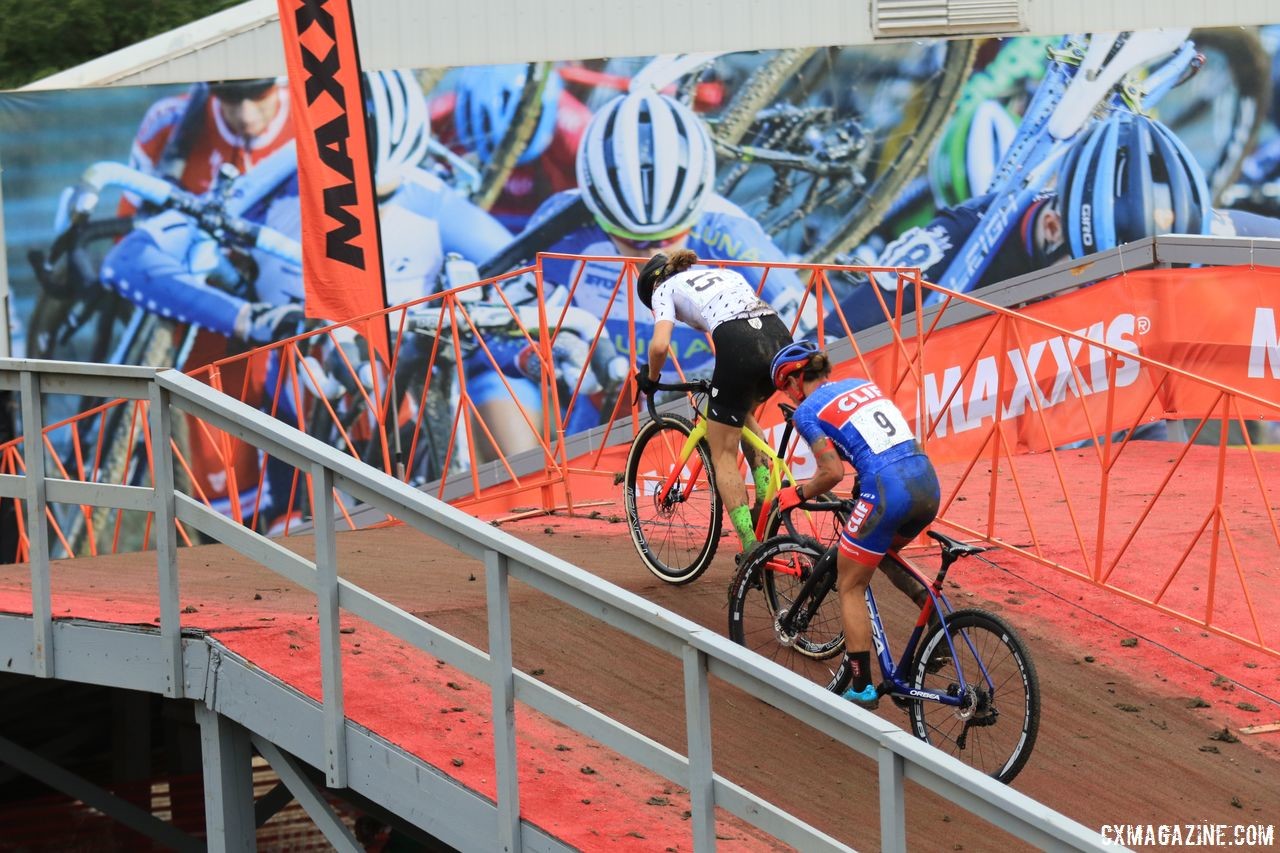
Rochette is targeting early-season success in New York, Iowa and Wisconsin. 2018 Jingle Cross Day 3, Sunday. © D. Mable / Cyclocross Magazine
CXM: I was impressed by how big of a target Pan-Ams has become for riders, and obviously last year was a big deal for you winning in Canada. How important is that event and defending your jersey this year?
MR: It’s super exciting. It’s a really big goal for me. It’s been cool being able to wear that jersey and represent North America. I’m hoping I can defend the title, and it’s in Canada again, so I think that’s an extra motivation.
CXM: You have two jerseys to choose from now. Do you get to make a decision in terms of which one you want to wear in Europe?
MR: Yep, you get to choose. I would wake up in the morning and wear the one I felt like wearing. It wasn’t a very scientific choice. Sometimes if it was super-muddy, I wouldn’t wear the white one to help with clean up.
CXM: We’ve seen Katie Compton has gone to Europe, Kaitie Keough is going to Europe, the U.S. rules for qualifying for Worlds have a more Euro focus, do you think doing well in Europe is becoming part of being considered a successful North American cyclocross racer?
MR: That is a good question. I would say everyone defines success in their own way. In my opinion, success is very personal in how you define it. Right now for me with what I’ve accomplished on the domestic scene and what I want to accomplish on the European scene, my biggest goals are for the international races in Europe because that’s where I haven’t been able to achieve my biggest goals yet.
But then again, I have a lot of partners who are in North America, and I really enjoy the scene in North America. I still have goals here, and I want to present on the scene because to be able to run this team, I need to be present in North America and I need to be present for my partners. Those partners and companies are who allow me to chase my dreams.
I see a difference between the things I need to do and the things I do for my personal dreams. I’m lucky they’re both tightly connected, but I do see a lot of importance in being in North America. Being with the people in North America who love cyclocross and race cyclocross and having direct contact with them is very important for me. I definitely still put a lot of importance on our scene here.
CXM: We enjoy having you. It’s always good to see you racing here at home.
MR: Thank you. I really enjoy it too. David and I were just planning my next block of training, and we were so excited about being at Rochester and being at Jingle Cross and Trek. It’s so great to see the people and feel the vibe of the scene; it’s really fun.
And that brings me back to success. What’s success to me is also being happy doing what I’m doing. Racing in North America really makes me happy, so that’s a very important part of this for me.
CXM: Speaking of partners, my understanding is Specialized has changed directions with the Specialized / Tenspeed Hero program toward a gravel focus, but are things in place for your program this coming season?
MR: Yes, everything is set in place for my program. Specialized is still a big part of it. With Tenspeed Hero things will be changing. I’ll be announcing all of the partners who will be on board this year.
Since you asked, with Tenspeed Hero, we won’t be working together anymore after this month. It was really sad because I love them so much. They are the coolest people ever, and I’m very very inspired by them. They’re so knowledgable and creative, being with them makes me smile. Working with them was super-stimulating. They make cool products, and I think it was a fun partnership for both of us.
I think most people think Tenspeed Hero is a really big company because they are so successful, but it’s actually a very very small company, and we just mutually agreed my needs were a little too big and our directions were not going to work from a business point of view. We still have dinner together and talk on the phone a lot, so it will be really sad we’re not working together, but at the same time, I know it’s good for everyone.
CXM: Last year, it was cool to see that you made the change from Clif to your own program and you had partners respond so positively. Were you surprised at the response you got for supporting CX Fever? Was it what you expected?
MR: I was very surprised, and I wouldn’t say it was expected. There are my goals and my dreams, and you never know how people will respond to that. I never expected people would respond so positively, but it was such a cool, warm surprise when I saw the response.
When we made that decision to really focus on cyclocross, David and I were ready to do it with nothing and no partners, but then when we started reaching out to people and the response was positive, it was so cool to see. Clif kept supporting me as well, which to me was unreal and shows how cool of a company they are.
It’s been really fun. This year we have even more partners I’m excited to share with everyone. The response from the public was really cool. I don’t know what part they enjoyed, but I could just feel their energy and positivity.
CXM: How is the CX Fever pepper doing?
MR: That’s a good question. The pepper is still alive and doing well, but he’s taking a little break. We won’t see the pepper on the new kit. I think the new kit will be pretty fun. I’m excited to share it. You should see it in the coming weeks. It’s very different, it’s very playful, and I think it’s cool. It kind of tells the story of who I am, and I’m excited because one of my really good friends came up with it. He kind of did it without really talking to me about it. I was like, ‘Huh, that’s awesome. Let’s do it!’
CXM: Speaking of another direction cyclocross is going, running your own privateer program is becoming a big part of the domestic scene. What are some of the biggest things you’ve learned from Year 1 and some of the biggest challenges?
MR: I’ve said it before, racing is my personal dream, but as much as a company might love being a part of that chase or that quest for success in cyclocross, I think that doesn’t necessarily bring money for them. They want to support you because they believe in what you’re doing, but at the same time, you have to find a way to bring them an actual return. That’s what been on our minds pretty much every day since we started; how can we bring a return for these partners?
And it’s different for every partner. They all have different goals and what they want to get out of the partnership. To me, it’s about listening to what their needs are, what they want and trying to bring that to them. Of course, the races and results are a big part of it, but there are other things. For example, this summer, we did a cyclocross camp, which was super fun and I think it’s been fun for my partners as well. We’ve organized a bunch of gravel rides. I’m always trying to think about what I can bring them and trying to not make it about what I can get from them. I think it has to be a very mutual relationship.
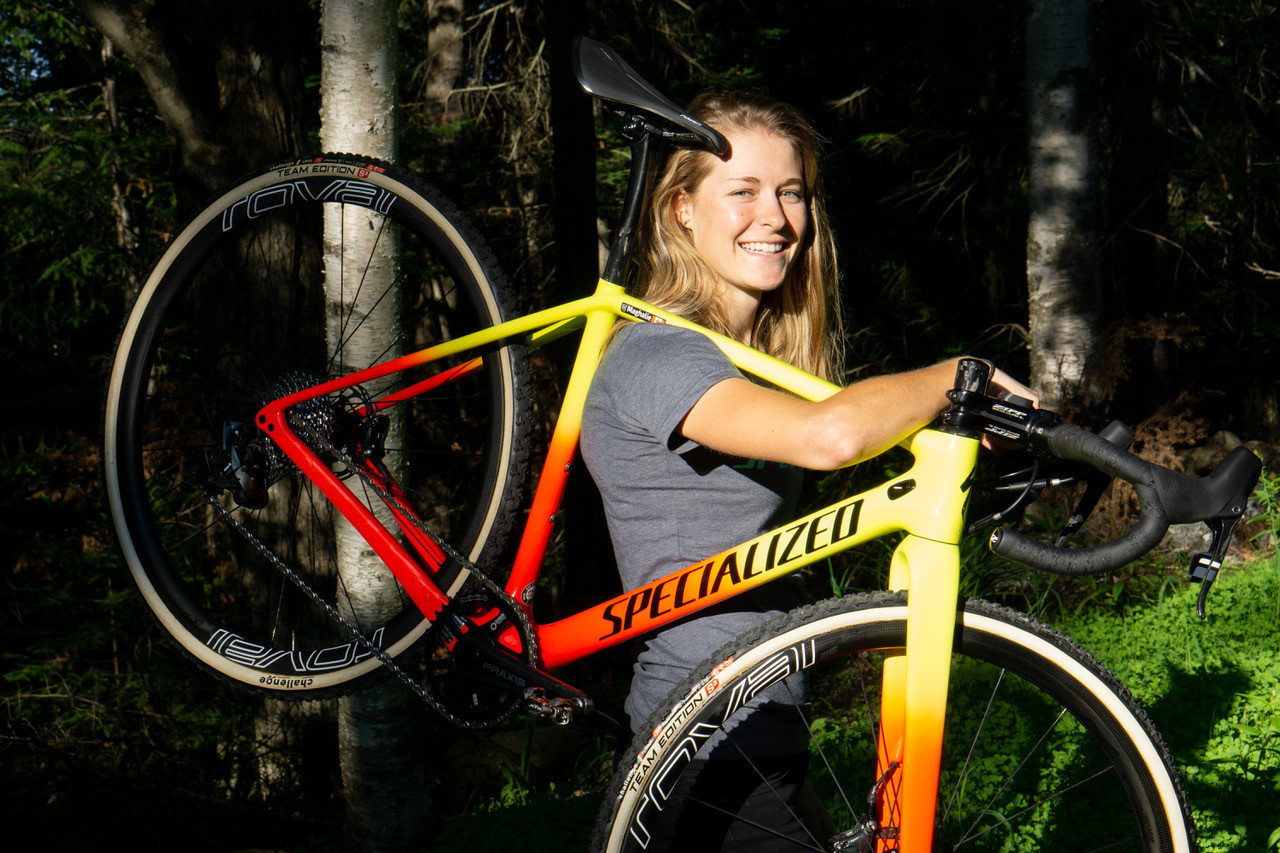
Strong partnerships with companies such as Specialized have been important to Rochette’s CX Fever success.
CXM: It sounds like gravel racing is something you’ve been enjoying. Will gravel continue to become a bigger part of what you do in the offseason?
MR: Yes. I love the scene of the gravel events. People are out there just having a blast, and it’s a great reminder of why you started cycling in the first place. It’s not sanctioned and people are really having fun. There are barbeques and beer afterward. I think it’s a positive vibe.
It’s funny we call it gravel now, but I’ve always enjoyed riding dirt roads and have always looked for them in my training. Now that there’s actually a scene for it is pretty cool. I will definitely be doing more of that.
CXM: Michael van den Ham said that too when he started doing gravel. He said, ‘We just called it bike riding when he was growing up.’
MR: I’m glad other people are discovering it. It’s safer, there are fewer cars, it feels like more of an adventure. So why not? It’s only positive.
CXM: When you ride gravel, do you ride your CruX? Did you get a Diverge?
MR: I have a Diverge. I’ve been riding the Diverge so much this summer. That bike is sweet with the little FutureShock at the front, so it’s really comfortable, but at the same time, it’s stiff enough so I can do intervals on it. I’ve been doing a lot of the long intervals on the Diverge and at the same time have been doing some bikepacking on it as well. I’ve been doing everything on that bike.
CXM: I guess not doing the World Cup rat race has its perks, huh?
MR: Oh yeah. It really does. I kind of said it quickly when we started chatting, but having actual time to train has been nice. Doing the World Cups, you’re always traveling, preparing for a race and then racing. This summer I’ve been able to do long blocks of training, then a couple days easy, and then another big block and build on that.
That has been so cool because for a few years I was racing 11 or 12 months out of the year. I know a lot of people are successfully doing that, I mean we’ve seen Wout and Mathieu van der Poel and Pauline and all these riders do well, but I’ve found it hard. I felt like I struggled to be at 100 percent because I was always trying, so having time to rest and train has been refreshing and fun for me.
CXM: From the outside, it’s awesome to see you relaxed and enjoying your training.
MR: Yeah, we’ll see once the season starts. We’ll see if it actually works, but right now it’s been good. You have to try new things, and if you’re always doing the same things, you’ll never know what works best for you. It feels good right now, but if it doesn’t work, well, we’ll try something different again. You gotta try new things, I think.
CXM: Well thanks for your time. It’s been awesome to catch up. Maybe we can do the beer-chugging contest with Katerina we talked about a few years ago?
MR: For sure. I’ll bring the beer. There’s a special beer from Quebec, an IPA from Quebec, that would be perfect.
CXM: I’ll run the idea by her. Hopefully she remembers.
MR: Oh, she’ll always be up for a beer-chugging contest.
CXM: Great. I’m looking forward to seeing how things work out for you this season, and later we can chat about whether it worked or not.
MR: Sounds good. Thanks again.























